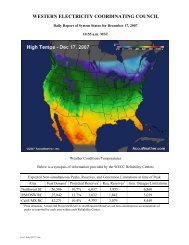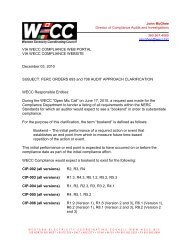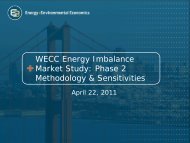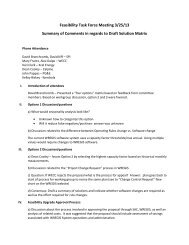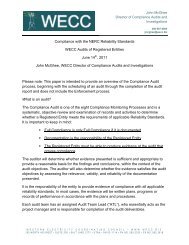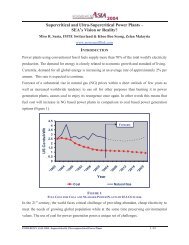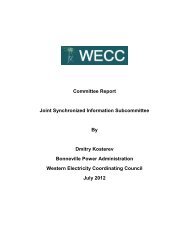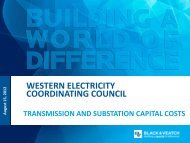Path Rating Catalog 2013 - Western Electricity Coordinating Council
Path Rating Catalog 2013 - Western Electricity Coordinating Council
Path Rating Catalog 2013 - Western Electricity Coordinating Council
You also want an ePaper? Increase the reach of your titles
YUMPU automatically turns print PDFs into web optimized ePapers that Google loves.
25. PacifiCorp/PG&E<br />
115 kV Interconnection<br />
Revised January <strong>2013</strong><br />
Accepted <strong>Rating</strong><br />
Existing <strong>Rating</strong><br />
Other<br />
Location: Southern Oregon/Northern California (Line 14)<br />
Definition:<br />
Sum of flow on Line 14, measured at Cascade.<br />
Transfer Limit: Winter Summer<br />
North to South: 100 MW * 80 MW<br />
South to North: 45 MW ** 45 MW **<br />
The thermal rating of this 115 kV line is 100/149 MVA Summer/Winter<br />
(397.5 ACSR conductor).<br />
Critical<br />
Disturbance<br />
that limits the<br />
transfer<br />
capability:<br />
When:<br />
System<br />
Conditions:<br />
Study Criteria<br />
* Due to load growth in the area, there are periods when the winter transfer<br />
limit may be reduced below 100 MW, sometimes as low as 80 MW.<br />
** The south to north non-simultaneous rating listed in the WECC Transfer<br />
Capability Diagram is 45 MW. This capability is rated under tie-line open<br />
south of phase shifter and is equivalent to the magnitude of PacifiCorp’s local<br />
area load.<br />
<strong>Path</strong> rating was established on April 19, 1984 with the publishing of the<br />
WECC progress report, by project owners.<br />
The powerflow and stability studies deriving the path rating, above, were<br />
conducted by PacifiCorp and PG&E.<br />
This interconnection operates in parallel with the California-Oregon Intertie<br />
(COI). In order to direct flow of the 100 MW south on Line 14, a<br />
75/100/125 MVA, 118 kV 0-60 degrees compensated phase shifter is<br />
installed at PacifiCorp’s Weed Junction substation, Weed Junction,<br />
California. This phase-shifting transformer regulates the flow of power,<br />
preventing power scheduled over it from flowing on the COI.<br />
The following stability simulations were made:<br />
A. Islanding Without the Line 14, 115 kV Tie<br />
This simulation assumes 3200 MW on the COI as well as 4163 MW on<br />
the Arizona to southern California path and indicates that minimum<br />
standards for stable operation can be achieved, complying with WECC<br />
criteria. Stability plot of the Devers 500 kV bus shows oscillations of<br />
increasing amplitude through the first 7-8 seconds, with decreasing<br />
amplitude thereafter.<br />
The minimum transient swing voltage was at the Devers 230 kV bus with<br />
81.7%. Use of the SDG&E’s Damping Coefficient Method demonstrates<br />
a 7.6% damping on this bus. Frequencies drop to 58.84 Hz minimum in<br />
California causing some under-frequency load shedding.<br />
PART VI Item 1-70



